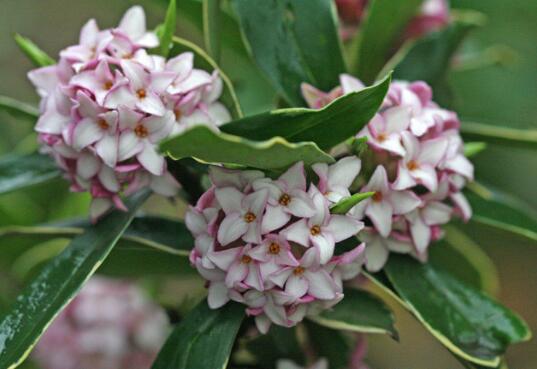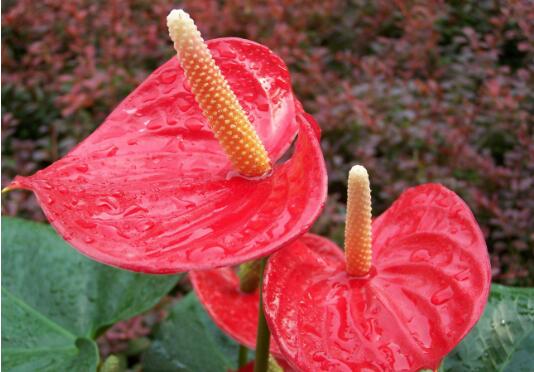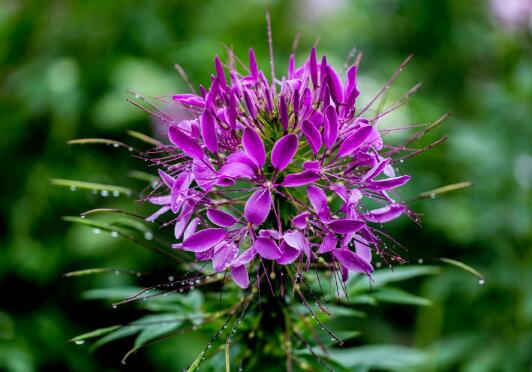What if Phnom Penh Daphne grows worms? disease and pest control of Phnom Penh Daphne / 2 insect pests and 3 diseases
In the growth process of Phnom Penh Daphne, the last thing we want to encounter is the problems of diseases and insect pests, which do great harm to the plant, not only affect the ornamental, but also lead to the phenomenon of plant death. So what if Phnom Penh Ruixiang grows worms? How to do the pest control of Phnom Penh Daphne? Next, the editor will take you to learn about it.
First, Phnom Penh Ruixiang worm how to do, to find the reason

If we want to know what to do with the long worm of Daphne odora in Phnom Penh, we first need to know what kind of insect is growing, so that we can deal with it pertinently, because the treatment methods of each kind of diseases and insect pests are different. Details are introduced below, interested friends can learn about it.
II. Pest control of Phnom Penh Daphne odora (pest)
Aphids
Aphids are one of the most destructive pests on earth, which are harmful to many plants, and Phnom Penh Daphne is no exception. It mainly feeds on the sap of the plant, which leads to the loss of a large amount of nutrients, and finally gradually withered and died.
Control methods: for aphids, the diseases and insect pests of Phnom Penh Daphne, we can use 40% imidacloprid water solvent 1500 to 2000 times to spray it, generally 2-3 times in a row can be eliminated.
Shell worm
The scale insect is a kind of pest that occurs in the growth process of many plants, and Phnom Penh Daphne is no exception. This pest mainly feeds on the sap in the leaves and stems of Phnom Penh. It will gradually absorb the juice, resulting in the gradual loss of nutrients in Phnom Penh, and finally shrinking.
Control method: when dealing with the disease and insect pest of Phnom Penh Daphne, we can use 2000 times of omethoate to spray, usually three times in a row can completely kill this pest.
III. Disease and pest control of Phnom Penh Daphne (disease)
Stem rot
Stem rot is a common disease in Phnom Penh. This disease mainly harms the roots of plants. When the disease occurs, the phloem of the roots will blacken and rot, and gradually develop to the roots, resulting in the decay and death of the whole plant.
Control method: when we deal with this disease and insect pest of Phnom Penh, we can use 38% cuproloxil 1000 times solution to irrigate the root, usually once every 5-7 days, and then recover after 3-4 times.
Fusarium wilt
Fusarium wilt is a disease caused by fungi, the pathogen generally invades from the root wound, and gradually spreads with the passage of the event, generally from morbidity to death, the course of disease is generally 15-45 days, is a very harmful disease.
Prevention and control methods: when we aim at the diseases and insect pests of Phnom Penh, we can use carbendazim or benzoate 800-1000 times to irrigate the roots of Phnom Penh, usually once a week, 5-6 times later can be cured.
Leaf spot disease
Leaf spot is a disease that may occur in many plants, and Phnom Penh Daphne is no exception. Small green dots will appear on the leaves at the time of the disease, and in the later stage, they will expand into larger disease spots that are nearly round, and in severe cases, the leaves will fall off completely and grow weaker until the whole plant dies.
Control methods: when dealing with the diseases and insect pests of Phnom Penh Daphne, we can use 500-800 times of methyl topiramate to spray the diseased plants, usually once every 7-10 days, 2-3 times can be cured.
What to do with the growth of insects in Daphne fragrance flowers? disease and pest control of Daphne fragrance flowers / 4 insects and 2 diseases
Daphne, a beautiful ornamental flower, not only looks good, but also has strong disease resistance, so it is very suitable for keeping indoors and is deeply loved by flower friends. But in the process of breeding, because of some reasons, Daphne odorifera will still grow insects and get sick, affecting plant growth. So, what should we do if the Ruixiang flowers grow worms? The following is the pest control of Ruixiang flowers, let's go and have a look!
First, how to do when the Ruixiang flower grows worms, spray with medicine
Although Daphne odorifera has strong disease resistance, it will also have insect pests and occasional diseases in the case of poor growth environment and improper maintenance. Among them, attention should be paid to insect pests such as aphids, red spiders, shell insects, earthworms, etc., and diseases include mosaic disease, root rot and so on. So what if the Ruixiang flowers grow worms? It's very simple, you just need to identify the pest, and then solve it by spraying.
II. Pest control of Daphne odorifera
1. Aphids
Although Daphne is not easy to infect insects, it is also vulnerable to aphids if the environment is different in hot summer weather. The insect generally parasites on the leaves and absorbs juice. Symptoms of being violated: the leaves of Daphne odoratum are yellow and withered, and in severe cases, the color of the flower can be reduced and wither quickly.
Prevention and control methods: after finding aphids, if the quantity is very small, you can take artificial control of aphids, brush off the aphids with a brush and bury them in the basin soil; when there are many aphids, you can use 40% Kuailing wettable powder 20003000 times liquid spray, the effect is particularly good.
2. Red spider
To say that Ruixiang flower long worm, red spider also needs to pay attention to, it uses mouthparts to pierce into the leaves of Ruixiang flowers to suck juice, so that the chlorophyll of the plant is destroyed, the leaves show gray-yellow spots or patches, and the leaves become withered and yellow, or even fall off.
Prevention and treatment: usually should pay attention to the observation of flowers, found that the above symptoms, timely check the back of the leaves. When individual leaves are damaged, insect leaves can be removed; when more leaves are damaged, propargite, dicofol, dimethoate, Huachongjing and other drugs should be sprayed as soon as possible to control them.
3. Scale insects
Shell insect, one of the insects that all flowers hate, Ruixiang flower long worm, may also be it. The insect often gathers on branches, leaves and fruits, and the mouthparts of adults and nymphs are inserted into the leaves and branches of taro to absorb juice, resulting in wilting leaves and inducing coal fouling disease.
Control methods: when there are few shell insects, gently brush them with a soft brush or wipe off with cotton balls and towel gourd stems; when there are too many shell insects, you can choose 40% omethoate, 50% malathion, 80% dichlorvos EC 800-1000 times, spray every 7-10 days, 2-3 times in a row, can effectively prevent the damage of shell insects.
4. Earthworms
Because the root system of Daphne odorifera has sweet taste, it is easier to attract earthworms. The insect will wrap around the root of Daphne odorifera, thus affecting the normal absorption of water and nutrients by the root system, resulting in poor growth of the plant.
Prevention and control methods: turn more pots, find earthworms hidden in the basin soil, get rid of them; during daily maintenance, do not put flowerpots on the soil to prevent earthworms from drilling into the bottom of the basin.
5. Mosaic disease
In addition to the long insects, Daphne odora also has occasional diseases, one of which is mosaic disease, which is the most common disease of flowers. Disease symptoms: the damaged leaves of Daphne odorifera showed color spots and deformities, resulting in poor flowering and stagnation of plant growth.
Prevention and control methods, diseased plants should be removed in time to reduce the source of the disease. When the disease is serious, 50% methyl topiramate 1200 times foliar spray can be used for disinfection to prevent transmission.
6. Root rot
In winter, if too much watering or poor drainage of the basin soil, resulting in the basin soil too wet, or the application of unripe organic fertilizer, Daphne flower is often prone to root rot. Symptoms: the roots and stems of Daphne odorifera are black and rotten.
Prevention and treatment: after the above diseases are found, the rotten parts of the flowers are cut off, applied with sulfur powder, and then replanted with fresh culture soil. After that, move the potted plant to a ventilated sunny place, and soon, the Daphne will return to health.
Control methods of diseases and insect pests of Daphne odora in Phnom Penh
The main diseases of Phnom Penh are stem rot, root rot and mosaic disease, and the main insect pests are aphids and shell insects. The prevention and control should adhere to the principle of "prevention and comprehensive control".
(1) strengthen the management of flower beds.
1. Strictly control the flow of diseased seedlings and propagate seedlings with diseased branches.
two。 Rational fertilization, scientific watering, nitrogen fertilizer should not be overweight, appropriate application of phosphorus and potassium fertilizer to enhance plant disease resistance.
3. To do a good job in the hygiene of the flower bed, the diseased plants, litter and weeds in the flower bed should be removed in time to eliminate the source of pathogens.
(2) chemical control.
1. Stem rot. The root neck is mainly damaged, the root neck becomes yellowish brown and rotten, and the plant wilts and dies. Choose 50% carbendazim 500 times solution or 40% carbendazim wettable powder 800 times solution, alternately spray 4-5 times, can be better prevention and control.
two。 Root rot. It is mainly caused by excessive wet waterlogging or excessive concentrated fertilization in the basin soil, which burns the root system. 1000-fold solution of 30% pinggangmycin powder or 500-fold solution of Gen Funing is selected and sprayed alternately for 4-5 times, which can be well prevented.
3. Mosaic disease. Spray with 10% virus king 600 times and control aphids at the same time.
4. Pests. Insect pests can occur all the year round, mainly with 40% omethoate emulsion 1000 times or 40% isocarbophos emulsion 1000 times and so on.
- Prev

For the control of diseases and insect pests, 2 insect pests and 2 diseases / pesticides have the best control effect.
In the growth process of the fire crane flower, the last thing we want to encounter is diseases and insect pests, this kind of problem is very harmful to the plant, if it is not dealt with in time, it is easy to lead to plant death. So what should we do if the flamingos grow worms? What should be done to prevent and control the diseases and insect pests of the flaming crane flower? Next, the editor will take you to learn about it.
- Next

What to do when the drunken butterfly flower grows, the pest control of the drunken butterfly flower / 2 insect pests 2 diseases
In the growth process of drunken butterfly flower, the last thing we want to encounter is the problem of diseases and insect pests, which do great harm to the plant, and may cause plant death if it is not dealt with in time. So what should I do if I get drunk and grow worms? How to control the diseases and insect pests of drunken butterfly flower
Related
- Fuxing push coffee new agricultural production and marketing class: lack of small-scale processing plants
- Jujube rice field leisure farm deep ploughing Yilan for five years to create a space for organic food and play
- Nongyu Farm-A trial of organic papaya for brave women with advanced technology
- Four points for attention in the prevention and control of diseases and insect pests of edible fungi
- How to add nutrient solution to Edible Fungi
- Is there any good way to control edible fungus mites?
- Open Inoculation Technology of Edible Fungi
- Is there any clever way to use fertilizer for edible fungus in winter?
- What agents are used to kill the pathogens of edible fungi in the mushroom shed?
- Rapid drying of Edible Fungi

